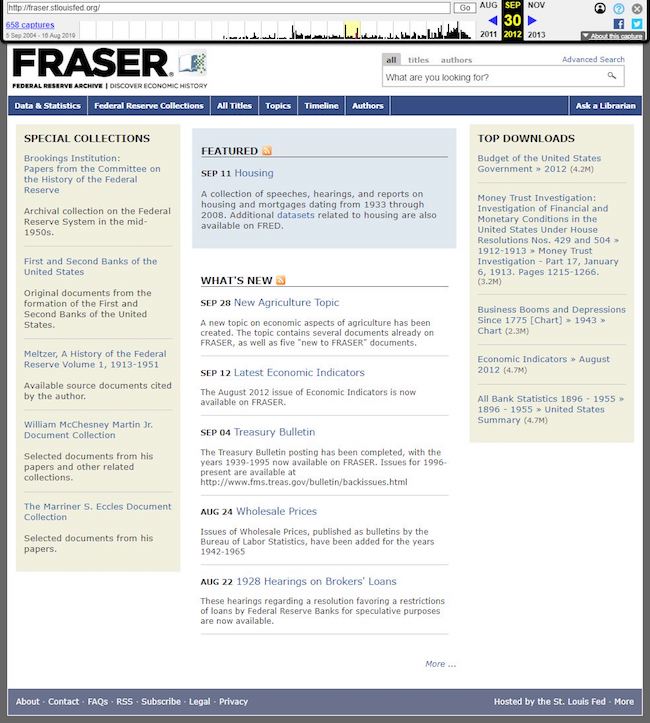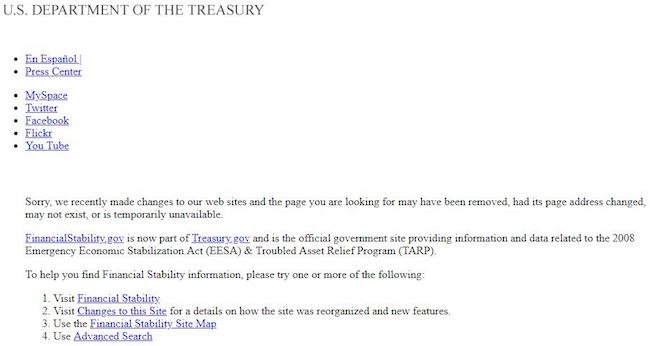…Well, maybe not that far back.
FRASER content dates back to 1781, but this article focuses on only the past couple decades. Why? That’s the timespan the Wayback Machine covers.
The Wayback Machine[1]was unveiled as a service of the Internet Archive on October 24, 2001. Founded in 1996, the Internet Archive began as an initiative to archive the Internet itself. Today, the Internet Archive and the Wayback Machine provide archived snapshots of over 370 billion webpages and make them available to anyone through the portal at https://archive.org/web/.
As our cultural heritage (a society’s legacy, including tangible and intangible cultural elements such as architecture, artwork, literature, folklore, traditions, and language) has become increasingly digital over recent decades, these digital artifacts provide a source of information for researchers, historians, and scholars. Beyond the cultural research value of the collection, snapshots can be used by individuals when they encounter “Error: 404 Not found” or other errors on webpages. Errors can occur because a page is temporarily unavailable, a site has been shut down, or a site’s URLs were changed during a redesign. Today, the non-profit Internet Archive boasts a mission to provide Universal Access to All Knowledge, expanding beyond archiving just Internet content into collecting media from partners and any registered user wishing to upload digital content such as books, videos, and even software programs.
On the flipside, the Wayback Machine can be used not just as a tool for exploring backward-facing issues to see what was once online, but as a forward-looking tool to help ensure that a particular page is saved right now and therefore available in the future. At https://archive.org/web/ there is a Save Page Now feature that allows a user to enter a URL and capture a snapshot.
So, what does the Wayback Machine have to do with FRASER? The answer is simple: It’s a tool that FRASER librarians have found useful in their work over the years. Let’s look at some examples.
FRASER librarians have used the Wayback Machine on an ad hoc basis to battle link rot and content drift. Some FRASER materials contain external links to related content, and we occasionally identify broken external links as part of our regular site maintenance. When that happens, it’s sometimes not entirely clear from the link itself what content we were trying to link to, so we’ve used the Wayback Machine to determine what the content was and if we can locate a replacement page. Typically, we can find the content’s new home or a suitable replacement.
We’ve also used the Wayback Machine to look at past versions of FRASER itself. While we always strive for high quality and accurate metadata on FRASER, we’re not perfect, and we sometimes come across a metadata value that just doesn’t make sense. When this happens, we investigate. Is the issue a data entry error or a problem resulting from one of the many metadata migrations and bulk updates that we have completed over the years? Looking at an older version of a page can sometimes be the fastest way to figure out what happened and what needs to be done to correct something. Similarly, during the writing of a recent article on the history of FRASER, we used the Wayback Machine in tracking the development of our mission statement and About Us page.

FRASER’s look in September 2012, as presented by the Wayback Machine
FRASER staff used the Wayback Machine quite extensively for one particular project. In December 2008, the Federal Reserve Bank of St. Louis launched an online hub of the latest news and developments regarding what would become known as the Financial Crisis of 2007-2009. As economic events unfolded, the site provided a detailed and up-to-date timeline of key events and actions surrounding the crisis. Over time, we found that the source materials linked in the timeline were in danger of disappearing. FRASER librarians captured snapshots and files from the source websites where we could and looked to the Wayback Machine to get copies of materials that had already disappeared from their original locations. The timeline and related resources now live on FRASER. This project is described in greater detail in Librarian Life: Preserving the Financial Crisis Timeline.

As an example, the Treasury Department’s Warrant Disposition Report from December 31, 2009, now redirects to an apology page, but the original page can be accessed via the Wayback Machine (and now also on FRASER).
Very recently, in a joint project with Fed in Print, the unified catalog of Federal Reserve publications, librarians and archivists across the Federal Reserve System worked to develop a more comprehensive set of Federal Reserve name references. The project involved matching names from many different authoritative sources (for example, James Bullard in VIAF, ORCiD, RePEc, and FRASER) to build records with each person’s affiliation, contact information, and unique IDs. While much of the work was automated, some names required more investigation. In some cases, an existing record included helpful links to CVs and personal websites, but many of those links were broken. The Wayback Machine provided an archived copy of each page to be used in confirming or rejecting a possible match.
Finally, we appreciate the Wayback Machine because it’s just entertaining to look back at the web of the past. (Check out Time Magazine’s 50 best websites, from 2003.) So, thank you, Internet Archive, for capturing these invaluable snapshots.
[1]“The Wayback Machine is named in reference to the famous Mr. Peabody’s WABAC (pronounced way-back) machine from the Rocky and Bullwinkle cartoon show.” https://help.archive.org/hc/en-us/articles/360004716091-Wayback-Machine-General-Information
© 2019, Federal Reserve Bank of St. Louis. The views expressed are those of the author(s) and do not necessarily reflect official positions of the Federal Reserve Bank of St. Louis or the Federal Reserve System.


 @FedFRASER
@FedFRASER